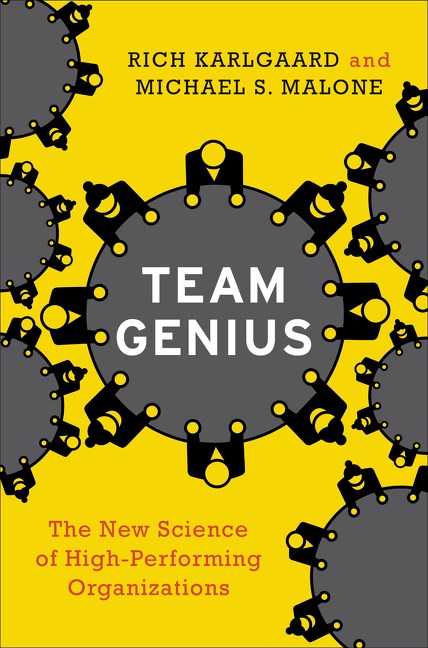Team Genius: The New Science of High-Performing Organizations
July 02, 2015
Two of our favorite writers, Rich Karlgaard and Michael S. Malone, have teamed up to tell us (and teach us) about the genius of teams.

Team Genius: The New Science of High-Performing Organizations by Rich Karlgaard & Michael S. Malone, HarperBusiness, 336 pages, $27.99, Hardcover, July 2015, ISBN 9780062302540
History is generally written about the extraordinary individuals that make it, or the large organizations of people—armies, political movements, and commercial enterprises—they assemble to do so. In their new book, Team Genius, Rich Karlgaard and Mike Malone bring the focus back to the sweet spot in between the two, those that actually get the work done at the ground level—teams.
So consistent has been the role of small, highly functioning teams that it would be easy to write an alternate story of humankind driven by the actions of small, organized groups operating at the pivot points of history: from the Spartans at Thermopylae and the twelve apostles at the birth of the Christian church to the Lewis and Clark Corps of Discovery to Lenin and his Bolsheviks in Saint Petersburg to the Bloomsbury Group to the dive-bombers at Midway to the Traitorous Eight at Fairchild Semiconductor to the fab four Beatles.
And, thinking of the Independence we Americans will be celebrating this weekend, we see a small core group of Founding Fathers pivotal to the American Revolution and the beginning of our ongoing experiment in self-government. But it’s not just history these two journalists pull from. They also pull in the latest scientific research on racial and gender diversity, anthropology, sociology, cognition, and the newly emerging field of social neuroscience.
In fact, Team Genius is a kind of “dream team” book in its own right. Rich Karlgaard and Mike Malone are two of our favorite writers. Malone’s Intel Trinity was the 2014 800-CEO-READ Business Book of the Year, and if it weren’t in the same category as Malone’s book, Karlgaard’s 2014 book, The Soft Edge, would have easily taken the top spot in the General Business category.
One of the most interesting and informative aspects of Team Genius is its discussion of team size. There are many optimal levels, and they are each fascinating on many levels. They’ve found that the magic sizes for teams are 7 (give or take 2), 150, and 1500.
7, incidentally, is the number of individuals that historian Richard B. Morris has identified as the key Founding Fathers.
150, “The Dunbar Number,” named after the British anthropologist who discovered it, is not only the average size of Welsh and British villages at the time of the Norman invasion and the number at which the Hutterites split their colonies, it is also likely around the number of Facebook friends you have or regular followers you have on Twitter. This is because that is “the maximum number of individuals with whom we can have a genuinely social relationship.”
1,500 is roughly the size of a large military battalion, the average size of a tribe in hunter-gatherer societies, and the number of employees at which Bill Hewlett and David Packard felt they were losing “a personal knowledge of everything that was going on” in their company.
Hewlett-Packard Co. in the 1950s and 1960s is sometimes described as the greatest corporation of all time. It was as technologically innovative as Apple was fifty years later, it offered more progressive employee programs (stock options, profit sharing, flex-time, and so forth) than any company before or since, and—not surprisingly—it set records for employee happiness and morale that have never again been matched by a large corporation.
Interestingly, in 1957, as the company approached 1,500 employees, the two founders began to sense that something had changed in their relationship to other HPers—and something radical had to be done. … So they decided it was time to break up HP from a monolithic company into a divisional one. Bill Hewlett said … “By dividing up into two or three small units, we might be able to keep that personal touch.” … That decision is credited with making Hewlett-Packard in the 1960s and 1970s one of the most nimble large companies of all time.
And being nimble is even more important in today’s fast-changing world economy. The authors tell us that, of all the qualities a company needs to be successful today, the most important is maneuverability, and that requires small, flexible, high-performing teams. What Bill and Dave sensed intuitively is born out in Rich and Mike’s research.
As we know, big ships turn slowly. But, no matter the size of the overall organization, the size of teams inside them—and how they relate to each other—can be maintained in a way that gives the overall structure more “give” to absorb shocks, and flexibility to act on opportunities. Team Genius will teach you how to think about team size, and the diversity within teams, to optimize their effectiveness. It will teach you how to build and maintain great teams, and how to know when it’s time to dismantle them and start anew. In short, they’ve developed “a new science of teams” to harness the inherent genius of them more systematically, instead of accidentally.




